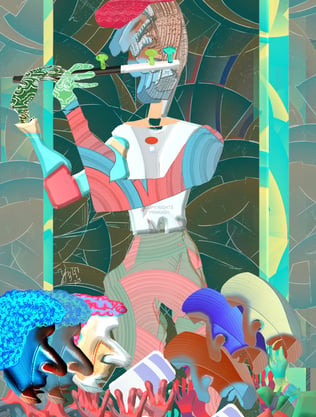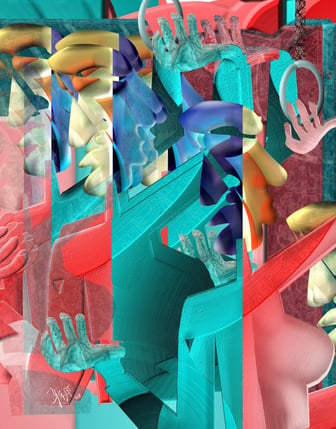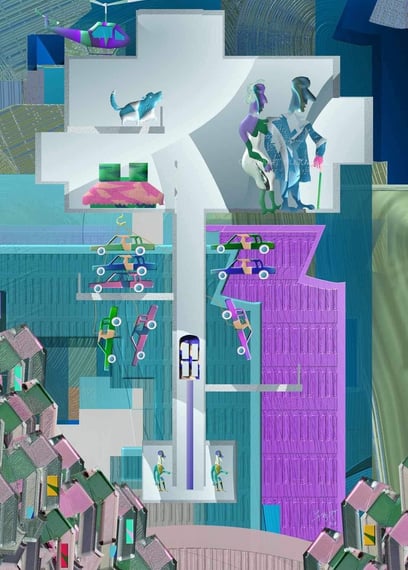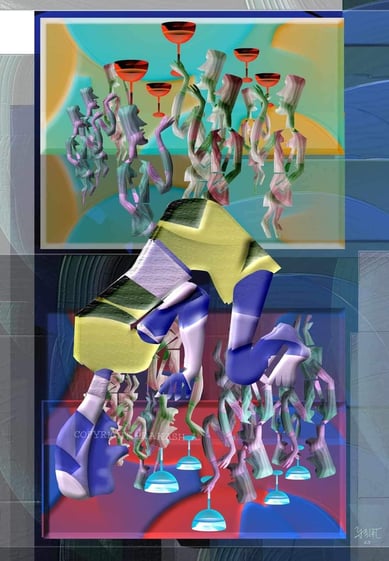INTERVIEWS WITH ARTISTS
Welcome to our exclusive artist interview series, where we delve into the creative minds behind captivating works of art. In these insightful conversations, we uncover the inspirations, techniques, and personal stories that shape each artist's unique artistic journey. Join us as we explore the diverse perspectives and artistic visions of renowned creators from around the world. ARTIST INTERVIEWS World Art Media WITH ARTIST PRAKASH AMBEGAONKAR
You didn’t come this far to stop.


ARTIST PRAKASH AMBEGAONKAR
In a world where architectural precision and artistic passion converge, there exists a visionary soul whose journey led him back to the colors of his childhood dreams. Born with an innate curiosity for aesthetics and art forms, this individual's early years were steeped in the principles of beauty and design. As the years unfolded, his path meandered through the realm of architecture, where he learned to shape space and form with a masterful hand. Within the walls of architectural school, the foundations of artistic expression were laid, and the young mind soaked in the wisdom of color theories and compositions. The practicalities of architectural practice then beckoned, offering invaluable experiences that further honed his compositional skills. Yet, beneath the architectural facade, the heart yearned for the strokes of a different canvas—the freedom of painting. And so, after a season of growth, the artist found the courage to return to his childhood passion. The call of visual art and art history became his guiding star, illuminating a path that he would now tread with unwavering determination. Let us know more about this artist, a creative genius through our exclusive interview!
WA: You made a significant transition from being a senior architect to becoming an abstract and surreal expression artist. What inspired this shift in your career path, and how has your background in architecture influenced your artistic style?
PRAKASH A: Painting was my childhood passion. I used to draw and paint a lot in my school days. However, due to my extremely busy schedule of Architectural practice, I was not able to spare time for painting. Ironically Architecture is what taught me the principles and nut bolts of Art. My drawing talent in childhood can be attributed to my ability to understand and reproduce visual forms. However later during my days of Architectural studies, I realized that what I had as an inborn gift was excellent skills in drawing, but that was not art. Art encompasses a much bigger picture of which skills are essential but a small part. Learning art is a lifetime story, which in a true sense started when I learned principles of composition and harmony in school or Architecture.
During my practice as an architect, I was able to explore hands-on, various facets of Art forms in real-life situations, thus fortifying my convictions about art forms and art languages. As a special interest in visual art, during my busy schedule, I was able to read a lot of books on the history of painting, study different art movements, and visit different places, Museums of the world where I was able to view the works of the masters alongside ancient urban practices and Architecture. All this has influenced me in my work as an Architect and an Artist. Primarily an Architect is a designer of space. He designs various systems that create a space that must be experienced by the user along with functionalities and sustainability of living or working inside it. In other words, the Architect is designing an experience for the user. I believe I have carried this thought convincingly in my work of art too. The studies told me that my work needs to have relevance historically. It exposed me to the various forms and thinking of modern art isms to ensure that I am not reinventing the wheel and at the same time not copying anyone. So, when I started devoting my full time to painting, I experimented a lot but was finally able to find my idiom.
WA: Abstract and surreal art often allows for the exploration of the subconscious and the unknown. How do you tap into these realms and translate them into visual expressions in your artwork?
PRAKASH A: The reason you are painting an abstract form is to show something which cannot be seen on the surface but dwells in the inner depth of your psyche. It could be something that may simply be at the surface level of your thoughts or something that is buried in the depths of the subconscious. It may surprise many that when I paint I don’t pre-draw. The whole process is spontaneous. I let my subconscious guide me through, then only challenging and spontaneous compositions are created. The cerebral part of the psyche does make certain critical decisions, but I try to keep that to a minimum. Usually when I am reviewing my painting my cerebral part comes into play as a dominant critique. What boils in your mind or what feeling you have in your mind while doing a painting is useless to the viewer unless it is communicated to him on the canvas through your visual language. How effectively you translate your vision is the toughest challenge an artist faces. The sustainability of the success of a painting depends upon how effective the form is no matter what the concept is. My images come from something that is dwelling in my mind for a long time. At an empty moment, there is a spark in my mind that results in an idea that can be transferred to the canvas.
WA: Your artwork is characterized by vibrant colors and dynamic forms. What emotions or narratives do you aim to evoke through these visual elements, and how do you achieve a balance between chaos and harmony in your compositions?
PRAKASH A: A composition can be very static or can be very dynamic. I have chosen dynamic compositions most of the time if they rhyme with my theme at hand. My choice of vibrant colors over muted colors is simply compositional. The vibrance of Colors employed strategically helps create the dynamism that I seek.
I am normally not afraid of creating some imbalance which normally I succeed in balancing by some challenging methods that I enjoy which also accentuate the expression I am seeking. I believe in drawing the viewer in, to take him on a journey of visual and cerebral excitement. Any composition without any chaos may become very rigid and uninteresting. This conditioning of our receptors is formulated by the nature that surrounds us. The human mind is at ease when it experiences something that resembles nature’s rules of harmony. The chaos is normally countered or complemented based on the theme by using some dominant elements or center of interest etc. The canvas I am using nowadays is digital. I use a very versatile program that allows me to draw on a digital tablet with real brush strokes with my stylus. My stylus is having a sensitivity to understand more than 4800 types of strokes depending upon my hand movement, pressure, and angle of holding. This allows me to put my forms in my desired visual language at a speed that allows spontaneous expression with my original individuality.
WA: Architecture and art both involve the creative process but in different ways. How do you approach the creative process as an artist, and how does it differ from your approach as an architect?
The transition from architecture to art is a leap into a more subjective and personal realm. How has this transformation affected your artistic voice and the messages you convey through your artwork?
PRAKASH A: As you have rightly indicated, Architecture and Art both involve the creative process. The main difference to me is the form. Painting is a form created on a two-dimensional surface whereas an Architect creates a three-dimensional form that surrounds the user. The utility of both has common art experience factors, however, Architecture has a very dominant function aspect. As a designer of space Architect designs the experience for the user. So, he is composing all the elements of this experience. However, Architecture cannot be a vision in the air like a painting, it must be backed by a functional and structural logic. An artist friend of mine sent me some colorful futuristic images drawn by him indicating I can send them to my Architect friends for creating Architecture. I had to explain to him that Architects don’t work like that, their creations are extensions of solid logic into something buildable. So, the Architect may stretch his imagination as much as possible but cannot forget the ground reality. Otherwise, that piece of Architecture will be Vain. As an architect I am used to composing in 3 dimensions, therefore in a painting, I am very comfortable composing in 3 D. My compositions use the space element, the voids and mass, the light and shade, and the light elements on color spontaneously without me being overly aware of it.
My present style has been coined by some art authorities as an abstraction in an imagined reality. Usually, I aim to make this reality a heightened reality for the viewer. It would have been a bit difficult to create with ease the backgrounds I create in my paintings without my Architectural designing abilities.
WA: Inspiration plays a crucial role in artistic expression. What are some of the key sources of inspiration for your abstract and surreal artwork, and how do you translate those inspirations into visual representations?
PRAKASH A: My inspirations come from my lifetime experiences and my practice of looking at things objectively and also from others’ points of view. I have this habit of empathizing with others and trying to analyze what is on their mind. So, the themes in my paintings are not necessarily my own experiences, but of others and the society at large.
WA: Your artwork often challenges conventional perceptions and invites viewers to interpret the meaning behind the imagery. How do you strike a balance between conveying your intended message and allowing space for individual interpretation?
PRAKASH A: In my visual language, I use my forms and compositions, color, textures, light and shade, and transparencies as a whole or in parts, which result in a certain response in the viewer’s mind. I accentuate certain feelings through the repetition of certain visual phrases. Understanding the responses at the subconscious level of the viewer is a lifetime study. How to relate these with your forms on canvas is the most crucial tool an artist needs to develop, which also is a lifetime journey. Some people will argue that every viewer is a bit different. Their responses depend on their own story and the paradigms they are holding about the world at large and the image they are viewing. However, this anomaly can be handled to make your painting more interesting, flexible yet more appealing. An artist does not need to hold the viewer to the whole meaning of every micro element in his painting. However, he needs to use the elements of his visual language which include the things to create a certain impact that generates a certain common response in their minds.
WA: Abstract and surreal art can be a departure from realism and representational forms. How do you navigate the fine line between abstraction and conveying a sense of meaning or purpose in your artwork?
PRAKASH A: A very good question, I think I answered some parts of it in my earlier comments but not completely. Abstraction is a concept and not a reality. It could be a derivational abstraction or an abstraction coming from the subconscious. It could be objective or non-objective. Abstraction tries to show something internal to the human mind which may not be evident on the surface as depicted in a purely representational painting. Coming from pure imagination, one may feel that it is a freehand to do anything. But that is not true. An artist must accept the reality that creation is incomplete until it reaches the receptor.
Visual artwork is meaning-free but not meaningless. In other words, the meaning does not drive its form, as opposed to a written text which is purely driven by the meaning. When an artist paints, he must go much further than writing his thoughts on paper. So, the artist must use a visual language that can communicate why he painted a certain artwork. From ‘what is painted to why it is painted’ was the transition that occurred from the representational era to the abstract era of today.
My derivative abstracts are in a sense filtered symbolic forms that the human mind can relate to. These are three-dimensional most of the time. This makes it possible to put them in an imagined reality that is three-dimensional where needed. They have an objective presence in my visual language. How to bring out the emotive expressions in these abstracted characters is always a challenge. I normally use body language and facial folds minimalized to a bare minimum to express what Is going on in their minds. This all happens spontaneously when I do a painting. My background objects, the space, light and shade, color, textures, brush strokes, etc also play a significant role in that expression. My style has been coined by some art critiques as Abstracted imagined reality as stated earlier.
WA: Exhibitions and showcasing your artwork are vital aspects of an artist's journey. Could you share any memorable experiences or challenges you have faced while exhibiting your abstract and surreal artwork?
PRAKASH A: My experience with the exhibitions has been encouraging. Right from the beginning of my exhibition journey even before finding my idiom the viewers were attracted by my originality, vibrant but harmonious color management, and compositions. Some of my work has been on display in some of the prestigious art galleries. Very recently I was able to have my work exhibited at Jehangir Art Gallery 2nd time. Several distinguished art personalities, art philosophers, collectors as well as emerging artists viewed my work. I had a chance to discuss a lot about art with them. One common response from all of them was, that my work was distinct, impressive, vibrant, and harmonious. The art historians complimented me for the originality of my art language. This exhibition also resulted in bulk offers from collectors and was a commercial success.
WA: How have these experiences shaped your artistic growth? Looking to the future, what aspirations do you have for your artistic career? How do you envision further developing your style and pushing the boundaries of abstract and surreal expression in your artwork?
PRAKASH A: I do intend to go deeper and deeper in my quest for art. However, I take a day at a time. Will continue working in search of higher truth with an open mind. All art forms are acceptable to me whether these belong to representational to Suprematism, does not make a difference. One needs to excel in the format he or she is working on. My criterion about my work is to remain creative, as I believe imagination is one of the four extraordinary endowments God has given to mankind that puts him at an edge over the animal kingdom. And therefore, imagination should be used wisely in service of humanity.
Thank you WORLD ART MEDIA for a profound questionnaire that allowed me to express myself.
Prakash Ambegaonkar












